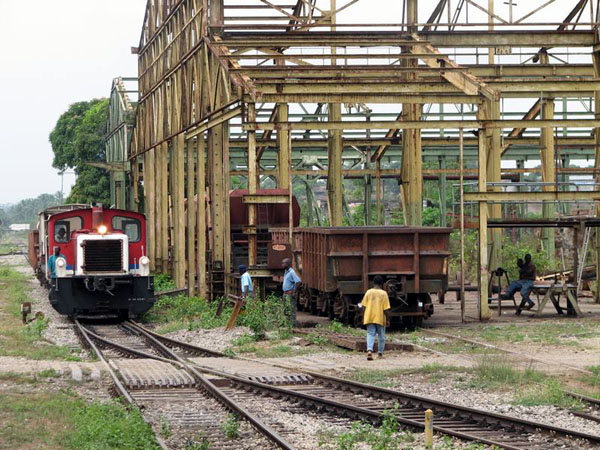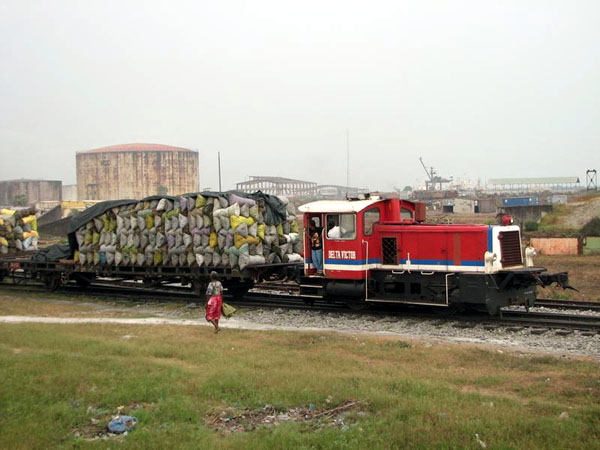The Bong Mine Railway, Liberia
Peter Nettleship reports below on a February 2007 visit. He revisited in 2010 - click here to read what he found then.
He has also visited the former Lamco Railway (added 18th June 2010).
The Bong Mine railway is operating along its full 80km route, from the jetty in Monrovia (just beyond the Free Port) up to Bong Mine town. It runs a passenger service four days a week (Monday, Tuesday, Thursday, Friday, I think, though I had conflicting days given) known as the Commercial Service, and freight six days a week (not Sunday), known as the Industrial Service. The freight leaves Monrovia first, about 0830, with the passenger close behind. They return from Bong Mine town in the same order, about 1500 or 1600 to get back to Monrovia before dark. There is no signalling, and the trains are regulated by radio to each locomotive.
The passenger train carries people and produce, stopping frequently,
bringing back such things as charcoal, fruit and vegetables for sale in the capital. There are no roads following the same route, so it is well
used. It generally consists of the three home-made passenger coaches (old bus bodies on flat trucks -- one more under construction) and four
or five flat trucks.
There is also a VIP coach: A very nice scratch-built body, on a four-wheel flat frame. Inside, it is equipped with rattan settees down
each side and a conference/coffee table down the middle. It has a
generator and air-conditioning unit, although these were not working on my recent trip. The flat trucks can also take vehicles: on my trip they
included a UN Land Cruiser for some of the German contingent on a day out, and, on the return, also a mechanical digger coming to Monrovia for
repair.
The freight brings down scrap iron and crushed stone from the mountain
of tailings up at the Mine to help in the massive amount of reconstruction work under way in Monrovia. I was told it can load to
about half a dozen stone trucks, plus two or three of scrap iron, depending on how much is available. Unloading at Monrovia is by
hand. The jetty and conveyor belt are not operational. I was told they had
brought down one load of iron ore pellets from the mine, but had problems unloading them so have not repeated the experiment yet. There
are about a dozen or so more wagons-full up at Bong Mine, with a
veritable forest growing out of them.
Motive power on the railway is three ex-DB 250hp diesel-hydraulic shunters, of which two were operational during my visit and the third waiting spare parts from Germany. They are liked as simple, rugged and easy to maintain; my loco performed admirably on the day I went up to Bong Mine, with just one stop to top up the radiator water from a stream. The railway is proud of its two female trainee drivers, one of whom was in charge on my trip: the first in Liberia, I was told... I saw hardly any recognisable bits of the original locos up at Bong Mine and was told they'd been completely broken up in the war. The new owners want more, and more powerful, locomotives and were, I was told, hoping to get 'something bigger' in 'the next few months'.
The mine itself and all the processing plant are completely derelict, with only a crusher operational for processing the stone to bring down to Monrovia. There is no prospect at present of reopening the mine: The remaining iron ore is quite low grade and is not thought to be economic to quarry in the medium-term future. The owners of the railway (now separate from the mine) have, however, started up a farming co-operative to provide work and bring produce to the capital.
The track is in good repair throughout and appears well-maintained. I was told it had been completely relaid in the 1980s with metal sleepers, which saved it during the war: Any wooden ones would have been stolen for firewood before they could have rotted away. The owners said they'd only had to do serious repair work for the first eight or nine kilometres out of Monrovia, and rebuild one river bridge, blown up by the ECOMOG peacekeepers in the early 1990s.
As can be imagined, the track is well-used by local people between trains, using large numbers of wheeled bamboo trolleys to move people and goods to the 'stations'. There was an unfortunate accident a couple of years ago when a train hit a trolley on a blind bend and two people who could not jump clear in time were killed.
I had no chance to visit Liberia's other railways, but was told the narrow-gauge line into Monrovia has gone completely. And I was told the the other big railway -- the 250km Lamco iron-ore line from the port of Buchanan, east of Monrovia -- is also completely derelict, and will need rebuilding from scratch. Mittal Steel of India signed a big deal last year to take over the railway and the mine, which has much bigger and better ore reserves, but nothing has happened on either front so far. I was told the deal was signed with the previous, transitional, government and is now being renegotiated by the rather more serious new Liberian administration of President Johnson-Sirleaf.
Finally... one intriguing and tantalising possibility, in a country like
Liberia, emerging from twenty years of war, one meets all kinds of 'businessmen' out for money and adventure. On the plane home were two
Brits, one of whom told me he'd seen (and had video of) a working stationary steam engine at a gold mine somewhere up-country in Liberia.
Not surprisingly, he would give me no more details, either of where it was, or of who he was...









